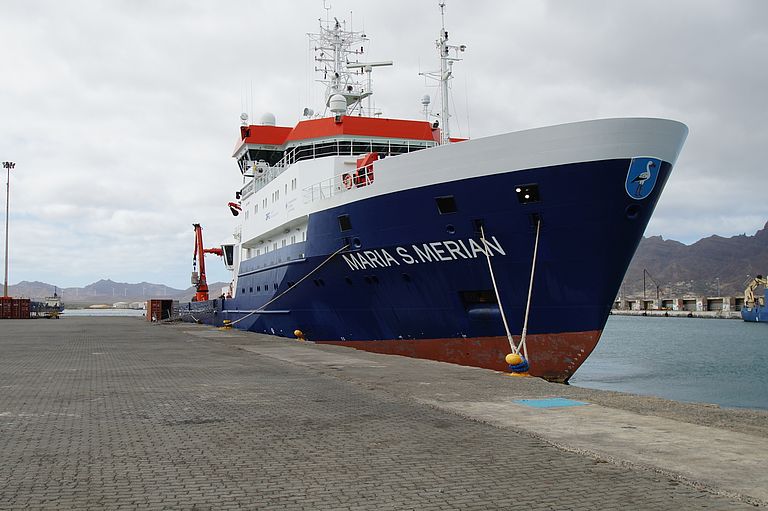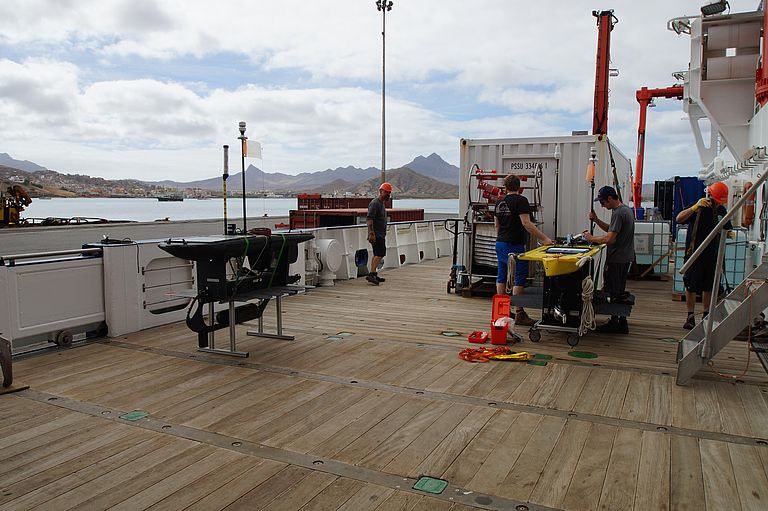Summit Meeting on an Underwater Mountain
Marine scientists from Kiel install observatory in the tropical Atlantic
(Joint press release of the cluster of excellence "The Future Ocean" an the GEOMAR Helmholtz Centre for Ocean Research Kiel)
The tropical and subtropical northeastern Atlantic is a very interesting region for climate scientists, marine biologists, oceanographers and for scientists in many other disciplines. That is why researchers from the GEOMAR Helmholtz Centre for Ocean Research Kiel and the Kiel Cluster of Excellence “The Future Ocean” have been active there for many years. In cooperation with colleagues from the Republic of Cape Verde they have regularly collected physical and biogeochemical data north of the island of São Vicente at the Cape Verde Ocean Observatory (CVOO) since 2006. The measurements help to better understand processes in this oceanic region and provide information about possible changes as a result of global climate change.
Now, a research team from Kiel together with colleagues from the MARUM in Bremen wants to investigate the Senghor Seamount, an underwater mountain 60 nautical miles north-east of the island of Sal, with a new interdisciplinary approach. “The seamount observatory, which we will be installing during our cruise, consists of a combination of stationary and mobile measuring devices. It is designed to record data for a period of six months,” says Dr. Björn Fiedler from GEOMAR. Björn Fiedler is chief scientist of the cruise with the German research vessel MARIA. S. MERIAN, which will leave the harbour of Mindelo on São Vicente tomorrow.
The islands of Sal and São Vicente both belong to the African island state of Cape Verde. It lies in the Central Atlantic, some 600 kilometers off the coast of West Africa. Around the islands, steep mountains rise several thousand meters from the seabed into the water column. Some of them almost reach the surface of the sea, providing topographic heterogeneity and resulting in unique ecosystems in the open ocean.
Due to these special conditions seamounts provide habitats for many fishes. “But various other pelagic organisms may also benefit from the increased food availability at seamounts,” says Dr. Henk-Jan Hoving, head of the project funded by the “Future Ocean”. The Seamounts are important for the island's inhabitants, as fishing is a key source of food and livelihood. The project involves close collaboration with Cape Verdean colleagues from the institute INDP, both during the cruise and in the data processing and distribution afterwards.
The first destination of RV MARIA S. MERIAN during the upcoming cruise is the CVOO north of São Vicente. Among other things, a towed camera system called PELAGIOS (Pelagic In Situ Observation System), will be used to perform video transects to investigate distribution, abundance and diversity of pelagic organisms. “The expedition is a premiere, because we are using the camera system for the first time below 1000 meters, in the bathypelagic zone, which is the largest but least explored environment on the planet. Thus we hope to get one of the first views into this deep pelagic ecosystem of the tropical Atlantic" emphasizes Dr. Hoving.
The second destination is the Senghor Seamount north of Sal. There, the moored and mobile systems will be installed, which will observe various ecosystem parameters for several months. The observation systems include a newly developed winch mooring, stationary biogeochemical and physical measuring devices and a timelapse camera positioned on the summit plateau. A coordinated swarm of autonomous sensor platforms complements the stationary equipment. These include two ‘wave gliders’, which carry out measurements at the sea surface and acoustically observe the upper 50 m, and an oceanographic glider, which oscillates back and forth between sea surface and 1000 meters of water depth.
“Since seamounts are typically investigated during research cruises, we usually only get a few snapshots of the biogeochemistry and ecology associated with these features in the open ocean. Thanks to the new technologies, it is now possible for us to collect data in a specific marine habitat over a longer period of time. The combination of the different data will provide us with detailed insights into the whole ecosystem of a tropical seamount as well as its temporal dynamics", emphasizes Dr. Björn Fiedler.
As a special guest Lisa-Marie Ode, a high-school student from Schleswig-Holstein (Germany), has joined the research team on the MARIA S. MERIAN. She has long been a member of GEOMAR's student research club. Now she was offered the opportunity to experience life on board a research vessel. “I am looking forward to the moment when the ship is leaving the harbour, and when for the first time we are not seeing land any more. Being in the middle of the Atlantic and looking over the scientists' shoulders and hopefully helping them will be a very special experience for me,” says Lisa-Marie.
High-res images:
The German RV MARIA S. MERIAN in Mindelo. Photo: Björn Fiedler, GEOMAR
On deck the equipment is being prepared for the expedition. Foto: Björn Fiedler, GEOMAR
Contact:
Jan Steffen (GEOMAR, Communication & Media), Tel.: +49 431 600-2811, presse(at)geomar.de




